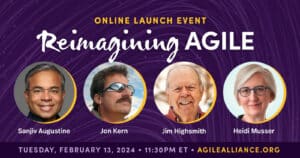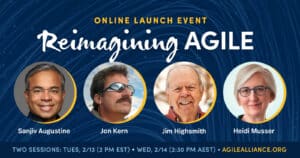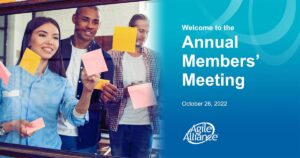Ben Kopel created a mental model that helps him describe and remember what is important about the agile mindset.
Join Ben as he quickly walks through the mental model and explains how agility and the agile mindset helps produce desired outcomes.
TRANSCRIPT
0:03
So I’m Ben Coppola. And I’ve got three minutes to talk about a mental model that I created for the agile mindset. So the three minute talks don’t get slides. So I made some handhelds. So I apologize if you can’t see them.
0:15
So I live in Chicago. And a couple years ago, I was asked to give a presentation to an executive group. And they wanted me to talk about agile and what agile means to me.
0:24
So when I think about agile, I don’t think about Scrum, or story points or time boxes or anything like that, to me, agile is a mindset. So agile is, it’s a way of being in a way of thinking. So that’s the way I think about it.
0:40
So I started writing down words that kind of resonate with me when I think of Agile in the agile mindset. And when I had that list of words, I ordered them in a way that made sense to me. And when I looked at the first letter of each word, I had this acronym. So this is what I came up with.
0:53
So I don’t know what you’ll see here. But what I saw is the word efficacy. So efficacy means the ability to produce the desired result. So I’m thinking, Okay, that’s pretty good. That’s a good goal. That’s definitely something you want to do for the customer.
1:06
So I’m gonna walk through each of these, each of the letters. So the first one, empowerment. So we definitely want teams to be empowered to make their own decisions control their own destiny. We don’t want teams to be micromanaged. So we want teams also to be able to fail and make mistakes and learn from those mistakes. So empowerment, super important.
1:27
Next, we’ve got flexibility. So most agile teams are working with software development. And as we know, software development is always going to change. So guaranteed 100%, things are gonna change. So it’s gonna be a lot easier if you know we’re ready for that change. And when the change comes, we can adapt to it easily. So we want to be flexible.
1:47
Next, we’ve got communication and collaboration. So this is where the human element comes to the table. You’ve got teams of people, not resources, but teams of people working to solve complex problems, right. So it’s gonna be a lot easier if those those teams have been together for a long time, they’re long lasting, they’ve started to build high levels of trust, high levels of empathy, they know how each other works, it’s just gonna be a lot easier for them to work together and have strong communication and collaboration. So that’s really important. And as Jerry Weinberg famously said, it’s always a people problem. So thinking about those interactions that humans have is really important. So you get that to your strong communication and collaboration.
2:25
Next, we’ve got iterative. So we want to move away from that waterfall thinking or we have defined upfront process where we think we know everything, because we don’t know everything. So we want to, you know, start building small pieces of functionality, put it in front of the customer, get feedback, incorporate that feedback, and iterate that way. So start iterating based on what we know, and sort of what we don’t know. So using an empirical process for that.
2:50
And last, but certainly not least, is continuous improvement. So we always want to be getting better. So thinking about, you know, whether it’s team dynamics or how we write user stories or how we interact with stakeholders are always trying to get better through continuous improvement.
3:06
So that is the mental model I created to help me think about the agile mindset through efficacy, so empowerment, flexibility, communication and collaboration, iterative and continuous improvement. Thank you.





